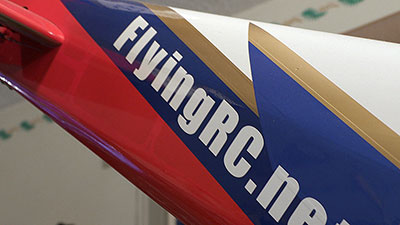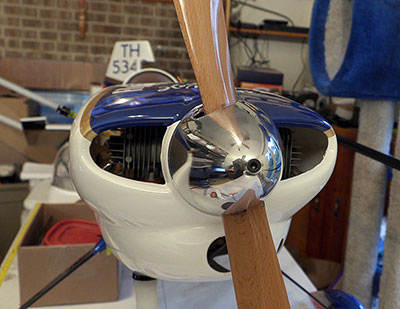


Text, photos and video by Tom Hintz
Posted - 11-8-2019
I have been a fan of the Edge 540 airframe design for a long time and the 3D Hobby Shop version has been suggested to me several times recently by FlyingRC.net viewers. I am a little embarrassed to admit this is my first 3D Hobby Shop plane. Having completed the build at this writing (before the maiden) I can say with confidence it will not be my last. Just when I thought I was done tearing holes in the sky I get sucked back in….

The 3D Hobby Shop 75" Edge 540 emerged from the shipping carton in perfect condition. The eye-catching covering scheme looks like it was done yesterday. This is no “crank-it-out”, two-tone deal. The red, white and blue base colors are augmented tastefully with gold stripes and a layered-in metallic blue that really stands out in the sunlight. The painting on the cowl matches the fuselage well and is also error-free.
The 3D Hobby Shop 75" Edge 540 has a wingspan of 75 inches (tips installed) and is 71.5 inches long. That produces a wing area of 1065 sq in supporting a trim 10.5-11.5 lbs flying weight. This airframe is designed for a 35cc engine and unlike many aerobats, it does not require over-powering to generate even the more violent 3D maneuvers.
The airframe is a healthy mix of laser-cut parts, jig assembly and a liberal use of carbon-laminated structure. The extensive “add light” theme of the materials selection includes carbon fiber landing gear and wing tube. Long stringers along the fuselage sides are carbon as is re enforcement between the motor box and fuselage. Even the mounting surface for the throttle servo sports a carbon lamination. The result of this combination of design and materials is a light but rigid airframe, the preferred combination for a plane designed to survive a days-worth of high-G thrashing in the air.
The horizontal stab comes assembled, needing only the gluing of the large pin hinges and dual fiberglass control horns. The mating surfaces between the horizontal stabilizer and the fuselage looked to be dead on in alignment with the wing tube. This is an area where laser-cut parts and jig assembly makes it easier for RC’rs assembling it on a kitchen table to get to the field with a great-flying plane because it is aligned properly.
The robust pin-style hinges used on all control surfaces are both tough and easy to install. All control surfaces are huge and double tapered allowing for ridiculous (my favorite) control throws. All the pin hinge holes were accurately drilled and needed no massaging to get the surface to align properly.
Something I did not expect was to find a one-piece elevator where most gas Edge 540 versions use dual elevator halves and dual servos. I like the simplicity and the additional weight (and cost) savings of losing one servo. The instructions suggest a minimum of 300 in oz servos on the elevator, rudder and ailerons, so I went with my normal Hitec HS-7954HS, 403 in oz servos on 7.4V receiver packs. A plane with giant control surfaces like the 3D Hobby Shop 75" Edge 540 benefits from being able to go to full throw quickly, at lots of airspeed, without a servo stalling.

The 3D Hobby Shop 75" Edge 540 is rated for a 35cc engine, so my DNA-based power quirk prohibits me from installing anything less than 40cc so the VVRC 40cc Twin "Classic" was chosen. Incidentally, the 3D Hobby Shop 75" Edge 540 cowl is about 9” wide where the cylinders are located. Between that width and the VVRC 40cc Twin "Classic" using small diameter, angle-mounted spark plugs, I was happy to discover that I did not have to cut openings in the cowl other than for exhaust extensions. That not only “slicks-up” the appearance of the 3D Hobby Shop 75" Edge 540, it eliminates one of the more time-consuming build steps.
I like that the cowl length is determined by the built-in mounting ring. The bottom of the cowl bolts into a vertically oriented blind nut. The upper corners of the cowl are also bolted to pre-installed blind nuts from inside the cockpit area. The result is a slick looking cowl with no easily visible fasteners.
Another feature I like about the 3D Hobby Shop 75" Edge 540 is the carbon fiber, tiller-style tail wheel. I hate the spring-type tail wheels, primarily because I have never gotten one to work. I realize that is likely due more to my deficiency than the spring-type design. However, I always get the tiller design tail wheels to work and they keep on working.
The 3D Hobby Shop 75" Edge 540 is designed to use electric or gas power. The canopy comes with dual spring latches installed that suffice with electric power. Also included is a bag with laser-cut wood and carbon laminated parts for a canopy mod to add latching add bolts for gas-powered planes. This modification could be a pain in the butt if it were not for the precision cutting and fitting of a logically designed system. The photo instruction sheet won’t win any awards on its own, but it gets the job done and I finished the modification in several minutes. Adding bolts is not a big deal but could prevent one of those afternoon walks in the surrounding countryside looking for an errant canopy.
While it seems most ARF’s have a hitch somewhere in their assembly git-a-long that never materialized with the 3D Hobby Shop 75" Edge 540. Everything fit well down to the standard-sized servo openings that needed no enlarging to fit standard servos as so often happens with other ARF’s. The fuselage is roomy enough for the radio gear if you keep in mind what all must be installed.
Throughout the assembly process I kept expecting to encounter a setback or two, but things just went together as intended. Even the landing gear “cuffs” at the fuselage were easily installed and nice looking. That is a definite departure from my normal bad attitude and frustration when installing “pretty parts” like that.
The 3D Hobby Shop 75" Edge 540 is well designed and built, using all the modern techniques and materials to produce a lightweight but sturdy aerobatic airframe. The fit and finish is first rate which contributed to the easy assembly and setup.
The 3D Hobby Shop 75" Edge 540 cost me $459.95 plus $70.09 shipping for a total of $530.04. That is not at all out of line with the real-world market for this type of plane. If the flight characteristics are as expected I consider the 3D Hobby Shop 75" Edge 540 to be a good deal.
3D Hobby Shop 75" Edge 540 web page – Click Here
Have a comment on this Review? –Email Me!